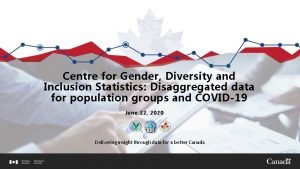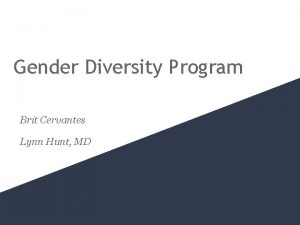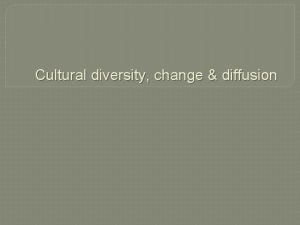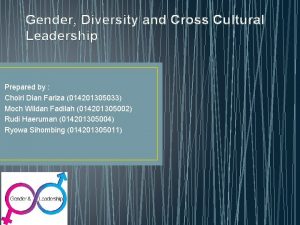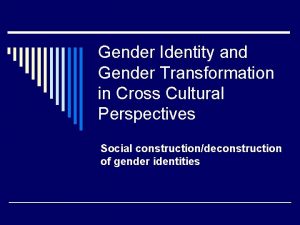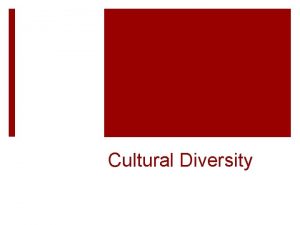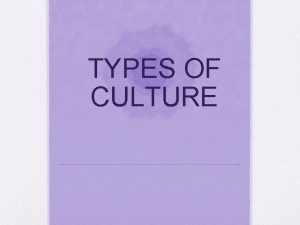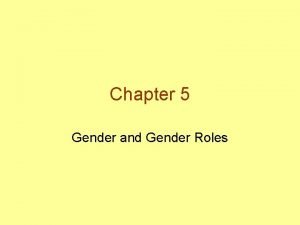Chapter 14 Gender Diversity and Cross Cultural Leadership





































- Slides: 37

Chapter 14 Gender, Diversity, and Cross. Cultural Leadership Lectured by Dr. Tan Saroeun, National University of Management Copyright © 2010 Pearson Education, Inc. publishing as Prentice Hall Leadership in Organizations

Copyright © 2010 Pearson Education, Inc. publishing as Prentice Hall Leadership in Organizations 10 -2

Learning Objectives Understand why cross-cultural research on leadership is important. Understand different types of crosscultural research. Understand the difficulties of studying cross-cultural leadership. Understand how cultural values are related to beliefs about effective Copyright © 2010 leadership. Pearson Education, Inc. Leadership in Organizations 14 -3 publishing as Prentice Hall

Learning Objectives (Cont. ) Understand how cultural values can influence leader behavior. Understand how gender issues have been studied and the limitations of this research. Understand the findings in research on gender differences in leadership. Understand how to manage diversity and Copyright © 2010 provide Pearson Education, Inc. Leadership in Organizations 14 -4 equal opportunities. publishing as Prentice Hall

Introduction to Cross-Cultural Leadership Importance of Cross-Cultural Research Increasing globalization Leaders need to influence people from other cultures Leaders need to understand how others interpret their actions Cultural Influences on Leadership Behavior the values are likely to be internalized by 14 -5 Leadership in Organizations managers Copyright © 2010 Pearson Education, Inc. publishing as Prentice Hall

Cross-Cultural Leadership Research: Types and Difficulties Types of Cross-Cultural Studies Methodological Problems Lack of equivalence of meaning for measures developed in one country and then used in order countries; កងវ ខ តសមភ ពខ ងអតថនយសរ បក រវ សវ ងតរវ អភវឌឍកនងបរទ សមយនងបនទ បមកបរ វ កនងបរទ សផស ង Confounding effects of demographic and situational variables that are not controlled by sampling លទធផលដ លធវ អ យអនន អថ រខ ងបរជ ស សតរនងសថ នភ ពមនតរវប នតរតពនត យដ យបចច កទ សជរ សរ សសណ កទ Response biases that differ across cultures. ភ ពលអ ងន ក រឆល យតបដ លខសបល កដ យវបបធមចរ Copyright © 2010 Pearson Education, Inc. publishing as Prentice Hall Leadership in Organizations 14 -6

Cross-Cultural Leadership Research: Types and Difficulties Lack of representative samples from which to generalize about countries with large regional differences; កងវ ខ តន សណ កជ តណ ងដ លសដ ងជ ទទ អពបរទ សជ ចរ នជ មយភ ពខសបល កត មតបនធៗ Level of analysis problems caused by using an overall culture score for the predictor (value dimension) but the behavior or attitudes of individuals as dependent variable. កមរតន បញហ វភ គបណត លឡ ងដ យបរ ពនទវបបធម ទ ងសរងសរ បក រទសសនទ យ (ទហតមល )បនត ឥរយ បថឬអកបប ករយ របសបគគលជ អថ រពងផអ ក Copyright © 2010 Pearson Education, Inc. publishing as Prentice Hall Leadership in Organizations 14 -7

Cross-Cultural Leadership Research: Types and Difficulties (Cont. ) Cross-Cultural Research on Behavior Differences Examples of Research on the Effects of Behavior Lowe, 1999 Dorfman and colleagues, 1997 Schaubroech, Lam, and Cha, 2007 Copyright © 2010 Pearson Education, Inc. publishing as Prentice Hall Leadership in Organizations 14 -8

The GLOBE Project Copyright © 2010 Pearson Education, Inc. publishing as Prentice Hall Leadership in Organizations 14 -9

Cultural Value Dimensions and Leadership Power Distance Uncertainty Avoidance Individualism (vs. Collectivism) Gender Egalitarianism Performance Orientation Human Orientation Copyright © 2010 Pearson Education, Inc. publishing as Prentice Hall Leadership in Organizations 14 -10

Power Distance The extent to which people accept differences in power and status among themselves. In a high power distance culture, leaders have more authority, they are entitled to special rights and privileges, they are less accessible, and they are not expected to share power with subordinates. KMlat. GMNac³ visal. Pa. BEdlbu. KÁlik. TTYlyk Pa. Bxus Ebøkkñúg. GMNac nigsßan Pa. B kñúgc. Me. Nam. BYke. K. kñúgvb, Fm’ KMlat. GMNacx<s; . Gñkdwkna. Mman. GMNac e. Rc. In BYke. Kmansi. T§i. BiessnigÉksi. T§i BYke. KGac TTYlsÁal; tict. Yc nig BYke. K Copyright © 2010 Pearson Education, Inc. Leadership in Organizations 14 -11 publishing as Prentice Hall min. Rt. Uvr. MBwg. Tuked. Im, Ic. Ul

For Example of Power Distance High : Russia , China, Philippines, Mexico, Venezuela, India. Medium: Netherlands, Italy, Pakistan, Japan, Spain, Greece. Low: Israel , Australia, Denmark, England, New Zealand, United States. Copyright © 2010 Pearson Education, Inc. publishing as Prentice Hall Leadership in Organizations 14 -12

Individualism In individualistic cultures, people are identified more by their own achievements than by their group memberships or contributions to collective success, and individual rights are more important than social responsibilities. visal. Pa. BEdlt. Mr. Uvkarnig. Pa. Bpþac; muxénbu. KÁl man sars. Mxan; e. Rc. In. Cag t. Mr. Uvkar. Ebbsm. Uh. Pa. Bén. GgÁPa. Bkargar b¤sgÁm. kñúgvb, Fm’EbbÉktþ mnus. SRt. Uve. Ks. MKal; e. Rc. Intam ry³sñaédpÞal; xøÜn Cagedaysma. Cikr. Ym Copyright © 2010 Pearson Education, Inc. publishing as Prentice Hall Leadership in Organizations 14 -13

For Example of Individualism High: United states, Netherlands, England, Australia, Canada, Belgium. Medium: Russia, Japan, Austria, Israel , Spain, India. Low: China, Indonesia, Thailand, Pakistan, Hong Kong, Venezuela. Copyright © 2010 Pearson Education, Inc. publishing as Prentice Hall Leadership in Organizations 14 -14

Uncertainty Avoidance In cultures with high avoidance of uncertainty, there is more fear of the unknown, security and stability are more important, conflict is avoided, plans and forecast are valued, and there is more emphasis on formal rules and regulations kñúgvb, Fm’Rbkbeday kar ecosvagx<s; én. Pa. Bminc, as; las; man. Pa. BPy½xøac e. Rc. Ineday. Pa. Bminc, as; xag snþisux esßr. Pa. B mansars. Mxan; e. Rc. In CMela. HRt. Uv ecosvag Epnkarnigkar. Büakr. N_ Rt. Uvpþl; t. Mél nig Copyright © 2010 Pearson Education, Inc. Leadership in Organizations 14 -15 publishing as Prentice Hall mankarsgát; ny½e. Rc. Inel. I c, ab; nig b. Tb. Ba¢a. CapøÚvkar.

For Example of High Avoidance High : Japan , France , Russia, Argentina, Spain, Belgium. Medium: China, Netherlands, Switzerland, Pakistan, Taiwan, Finland. Low: Singapore, Hong Kong, Denmark, England, Sweden, United States. Copyright © 2010 Pearson Education, Inc. publishing as Prentice Hall Leadership in Organizations 14 -16

Gender Egalitarianism In cultures with high gender egalitarianism, sex roles are not clearly differentiated, jobs are not segregates by gender, and attributes such as compassion, empathy, and intuition are as important as assertiveness, competitiveness, and objective rationality. kñúgvb, Fm’Rbkbeday sm. Pa. Be. PTx<s; t. Yna. TI e. PTmin)ane. FVIe. Gayxus. Kñaxag kargare. T min. Rt. Uvdak; e. Gayen. Aeday ELkedaye. PTe. LIy nigektn. PNнd. Uc CaesckþIGa. Nit. Gas. Ur sman citþ nig GPnþr. BaØa. N Copyright © 2010 Pearson Education, Inc. Leadership in Organizations 14 -17 publishing as Prentice Hall mansars. Mxan; d. Uc rkbdi

For Example of Egalitarianism High : Denmark, Norway, Finland, Sweden, Netherlands, Chile. Medium: Canada, Indonesia, Israel , France, India, China. Low: Japan, Austria, Italy, Mexico, Venezuela, Switzerland. Copyright © 2010 Pearson Education, Inc. publishing as Prentice Hall Leadership in Organizations 14 -18

Performance Orientation is the extent to which high performance and individual achievement are valued. (Javidan, 2004) Related values and attributes include hard work, responsibility, competitiveness, peristence, initiative, pragmatism, and acquisition of new skills. In societies with strong performance orientation values, results are emphasized more than people. Copyright © 2010 Pearson Education, Inc. publishing as Prentice Hall Leadership in Organizations 14 -19

Performance Orientation Accomplishing a task effectively can be take priority over individual needs or family loyalty. Performanceorientation is affected by the climate of a country and tends to be higher in latitudes with colder climates. Orientation values were also strongly related to religion. Copyright © 2010 Pearson Education, Inc. publishing as Prentice Hall Leadership in Organizations 14 -20

Human Orientation Human orientation means a strong concern for the welfare of other people and the willingness to sacrifice one’s own selfinterest to halp others. Key values include : altruism, benevolence, kindness, compassion, love, and generosity. These values tend to be associated with stronger needs for affiliation and belongingness than for pleasure, achievement, or power. Societies with a strong humane orientation Copyright © 2010 Pearson Education, Inc. Leadership in Organizations 14 -21 publishing as Prentice Hall encourage and reward individuals for

Copyright © 2010 Pearson Education, Inc. publishing as Prentice Hall Leadership in Organizations 14 -22

Evaluation of the Cross-Cultural Research 1. How does actual behavior of leaders differ across cultural value clusters and for different countries? ត ឥរយ បថពតបរ កដរបសអនកដកន ខសបល កតមល វបបធមចងក មនងបរទ សខសបល កយ ងដចមត ច? 2. How are leader values and behaviors jointly influenced by personality (and developmental experiences), company culture, and national culture? ត តមល អនកដកន នងឥរយ បថជ ឥទធពលដ យចរតលកខណ (នងបទពស ធនអភវឌឍ) វបបធមករមហននងវបបធមជ ត យ ងដចមត ច ? 3. How useful is the distinction between actual and ideal cultural values for understanding implicit theories of leadership and patterns of leadership behavior? ត ម នស រ បរយ ជនខសបល ករវ ងតមល វបបធមខ ងឧតតមគតនងជ កសត ងសរ បក រយលដង Copyright © 2010ទរសតន ភ ពជ អនកដកន នងគរន ឥរយ បថភ ពជ អនកដកន យ ងដចមត ច? Pearson Education, Inc. Leadership in Organizations ។ publishing as Prentice Hall 14 -23

Evaluation of the Cross-Cultural Research (Cont. ) 4. How difficult is it to change an organization’s cultural values when they are not consistent with the societal values where the organization’s facilities are located? ត ម នក រពប កដ លផល សបតរតមល វបបធមរបសអងគភ ពព លដ លពកវ មនបនសគន ជ មយតមល សងគមដ លអងគភ ពត ងន យ ងដចមត ច ? 5. How fast are cultural values changing, and what are the primary determinants of culture changes that are relevant for leadership? ត ក រផល សបតរតមល វបបធមល នយ ងដចមត ច នង កតត កណតអវ ន ក រផល សបតរវបបធមចមបងដ លព កពនធសរ បភ ពជ អនកដកន 6. What types of leadership traits, skills, and developmental experiences are most useful to prepare someone for a leadership assignment in a different culture? ត បរភ ទចរតសគ ល ជន ញនងបទពស ធនអភវឌឍអវម នបរយ ជន Copyright © 2010 Pearson Education, Inc. Leadership in Organizations បផតដ មបបរ បធ បនរណ មន កសរ បកចចក រភ ពជ អនកដកន កនងវបបធមខសគន ។ publishing as Prentice Hall 14 -24

Gender and Leadership Sex-Based Discrimination Explanations for the Glass Ceiling Theories of Feminine Advantage Findings in Research on Gender Differences Limitations on Research on Gender Differences Identifying Causes and Reducing Discrimination Summary of Leader Gender Research Copyright © 2010 Pearson Education, Inc. publishing as Prentice Hall Leadership in Organizations 14 -25

Sex-based Discrimination The strong tendency to favor men over women in filling high-level leadership positions has been referred to as the glass ceiling. TMenarya: gxøa. Mgc. Me. Ba. HKu. Nb. MN ac; bursel. IRsþIkñúgkar b. Me. Bjmuxd. MENg. Pa. BCa. Gñkdwkna Mk. Mritx<s; Cakarel. Ik t. Mek. IgxøÜnÉg. Copyright © 2010 Pearson Education, Inc. publishing as Prentice Hall Leadership in Organizations 14 -26

Implicit Theories. Biased beliefs about the skills and behaviors necessary for effective leadership are one reason for sex-based discrimination. RTwsþIEbb. Baküs. Md. Idac; xat³ CMen. O l. Me. Gog. GMBICMnaj nig riyabfca. M)ac; s. Mrab; Pa. BCa. Gñk dwkna. MEdlman. Rbsi. T§ Pa. BCam. Ulehtus. Mrab; karer. Ise. GIgxagm Copyright © 2010 Pearson Education, Inc. publishing as Prentice Hall Leadership in Organizations 14 -27

Implicit Theories (Cont’d) The experience of working for men and women leaders over a period of time can reduce the effects of gender stereotypes on evaluation of the leaders. b. TBiesa. Fn_énkare. FVIkargars. Mrab; G ñkdwkna. Mburs nig RsþIel. Id. MNak; kaléne. Blevla. Gacbnßyl T§plén lkçN³e. PTc. Me. Ba. Hkarvayt. Mélén. Gñkd wkna. M. Copyright © 2010 Pearson Education, Inc. publishing as Prentice Hall Leadership in Organizations 14 -28

Explanation for the Glass Celing Sex-based discrimination in leadership selection also reflects the influence of popular stereotypes and role expectations for men and women (Heilman, 2001). When women leaders use masculine behaviors, they are evaluated less favorably than men who use them. e. Bl. Gñkdwkna. MCa. RsþIe. Rb. Iriyabf. Caburs BYke. Kvayt. Mél. Ka. MRT tic. Cagburs. Edle. Rb. Iva. Copyright © 2010 Pearson Education, Inc. publishing as Prentice Hall Leadership in Organizations 14 -29

Other Explanations Other possible reasons for the glass ceiling have been suggested , including 1. A lack of opportunity to gain experience and visibility in types of positions that would facilitate advancement, kg. VHxat» kased. Im, ITTYlb. T Biesa. Fn_ nig kar bgðaje. Gaye. XIjkñúg. Rbe. PTénmuxd. MENg. Edl Rt. Uvs. Mrbs. Mr. Yle. Gay r. Ikc. Mer. Ine. LIg. Copyright © 2010 Pearson Education, Inc. publishing as Prentice Hall Leadership in Organizations 10 -30

Other Explanations (Cont’d) 2. Higher standards of performance for women than for men, b. Tdæanénkarb. Me. Bjmuxgars. Mrab; RsþIx<s; Cagbur s. 3. Exclusion of women from informal networks that aid advancement, min. TTYlyk. RsþIBIb. Nþajkargare. Rk. A pøÚvkar. Edl. CYye. Gaymankarc. Mer. In. 4. Lack of encouragement and opportunity for developmental activities, kg. VHxaténkarel. Ik. Twkcitþ nig » kass. Mrab; skmµPa. BGPiv. DÆ. Copyright © 2010 Pearson Education, Inc. publishing as Prentice Hall Leadership in Organizations 14 -31

Other Explanations (Cont’d) 5. Lack of opportunity for effective mentoring, kg. VHxatén» kass. Mrab; kar. ENna. Me. Gayman. R bsi. T§Pa. B/ 6. Difficulties created by competing family demands, kar. Bi)akm. Yye. Tot. Rt. Uv. Rbwg. ERbgt. Mr. Uvkar. R KYsarpg/ 7. A lack of strong action by top management to ensure equal opportunity, and karx. VHxaténskmµPa. Bxøa. Mgkøaeday Copyright © 2010 Pearson Education, Inc. publishing as Prentice Hall Leadership in Organizations 14 -32

Other Explanations (Cont’d) 8. Intentional efforts by some men to retain control of the most powerful positions for themselves. kar. Rbwg. ERbgedayectnarbs; bursxøHed. Im, I rk. Sakar. Rt. Yt. Binitü énmuxd. MENgd¾man. GMNace. Rc. Inb. Mput s. Mrab; BYkxøÜn. Copyright © 2010 Pearson Education, Inc. publishing as Prentice Hall Leadership in Organizations 14 -33

Feminine Advantage Women are more concerned with consensus building, inclusiveness, and interpersonal relations; they are more willing to develop and nurture subordinates and share power with them. RsþIRt. Uv. Cab; Tak; Tge. Rc. In. Cam. Yykarksag. Rb Camti Pa. Brab; b. Ba©Úl nig. TMnak; TMng. Gnþrbu. KÁl BYke. KmanqnÞHe. Rc. Ined. Im, I GPiv. DÆ nig. Gb; r. M Gñke. RkambgÁab; nig Copyright © 2010 Pearson Education, Inc. publishing as Prentice Hall Leadership in Organizations 14 -34

Managing Diversity Copyright © 2010 Pearson Education, Inc. publishing as Prentice Hall Leadership in Organizations 14 -35

Managing Diversity (Cont. ) Fostering Appreciation and Tolerance Providing Equal Opportunity Copyright © 2010 Pearson Education, Inc. publishing as Prentice Hall Leadership in Organizations 14 -36

All rights reserved. No part of this publication may be reproduced, stored in a retrieval system, or transmitted, in any form or by any means, electronic, mechanical, photocopying, recording, or otherwise, without the prior written permission of the publisher. Printed in the United States of America. Copyright © 2010 Pearson Education, Inc. publishing as Prentice Hall Leadership in Organizations 14 -37
 Strategic gender needs and practical gender needs
Strategic gender needs and practical gender needs Importance of cross cultural leadership
Importance of cross cultural leadership Chapter 4 communication and cultural diversity
Chapter 4 communication and cultural diversity Cultural diversity and conformity
Cultural diversity and conformity Cultural diversity and conformity chapter test form a
Cultural diversity and conformity chapter test form a Examples of countercultures
Examples of countercultures Culturological assessment
Culturological assessment Cultural diversity 3939 answers
Cultural diversity 3939 answers Centre for gender diversity and inclusion statistics
Centre for gender diversity and inclusion statistics Centre for gender diversity and inclusion statistics
Centre for gender diversity and inclusion statistics Gender based violence
Gender based violence Chapter 9 cultural diversity
Chapter 9 cultural diversity 2009 delmar cengage learning
2009 delmar cengage learning Brit cervantes
Brit cervantes Why is genetic diversity important
Why is genetic diversity important Genetic diversity vs species diversity
Genetic diversity vs species diversity Cultural diversity and conformity guided reading section 3
Cultural diversity and conformity guided reading section 3 Cultural diversity and conformity section 1
Cultural diversity and conformity section 1 Cultural homogenization pros and cons
Cultural homogenization pros and cons Cultural diversity and conformity section 1
Cultural diversity and conformity section 1 Positive and negative effects of cultural diversity
Positive and negative effects of cultural diversity Culture trait
Culture trait Chapter 22 reaching out cross-cultural interactions
Chapter 22 reaching out cross-cultural interactions Chapter 22 reaching out cross-cultural interactions
Chapter 22 reaching out cross-cultural interactions Chapter 22 reaching out cross-cultural interactions
Chapter 22 reaching out cross-cultural interactions United states salad bowl
United states salad bowl Tcole cultural diversity 3939
Tcole cultural diversity 3939 Cultural diversity examples
Cultural diversity examples Are west african bantu
Are west african bantu The phlebotomy textbook
The phlebotomy textbook Socio-cultural diversity
Socio-cultural diversity Whole school approach to cultural diversity
Whole school approach to cultural diversity Cultural diversity a primer for the human services
Cultural diversity a primer for the human services Cultural diversity means a range of different
Cultural diversity means a range of different Cultural diversity 3939 answers
Cultural diversity 3939 answers Four skills of cultural diversity competence
Four skills of cultural diversity competence Cultural diversity hands
Cultural diversity hands Diversity
Diversity









